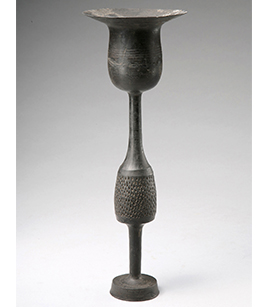Longshan Culture’s ceramics

FILE PHOTO: An “eggshell” ceramic cup belonging to the Longshan culture
The Longshan Culture was a late Neolithic culture which flourished in the middle and lower reaches of the Yellow River from about 2,500 to 2,000 BCE. The first archaeological discovery of this culture took place at the Chengziya site in Longshan Town, Jinan, Shandong Province, in 1928. The Longshan Culture is notable for its highly polished black pottery. Ancient ceramicists used a unique sealed firing technique that allowed carbon to infiltrate the pores of the clay. This produced a completely black surface. Therefore, the Longshan Culture is also known as the Black Pottery Culture.
Before excavations at the Chengziya site, Neolithic pottery unearthed in China was mostly painted or terracotta with a very high sand content. In contrast with earlier pottery, Longshan black ceramic artifacts were refined, wheel-made, and especially thin. The finest specimens are known as “eggshell pottery,” which is characterized by an extremely thin body, burnished to a hard, smooth surface, giving it a metallic appearance. Eggshell pottery was made from the fine silt deposited in rivers and lakes. This art represents the most impressive combination of rustic materials and sophisticated craftsmanship emerging at that time.
Among all the unearthed black ceramic artifacts from the Longshan Culture, a few eggshell cups stand out due to their marvelously thin bodies. These ceramic cups have an average thickness of less than 0.5 mm, with the thinnest being only 0.3 mm, and some weighing only about 40 grams. The average water absorption of these cups is only 0.43%. According to archaeologists’ speculation, these vessels were probably for ceremonial use. They might have been special drinking vessels used in ritual ceremonies, reserved for distinguished persons, as all of these cups were excavated in large tombs with other rich burial items.
